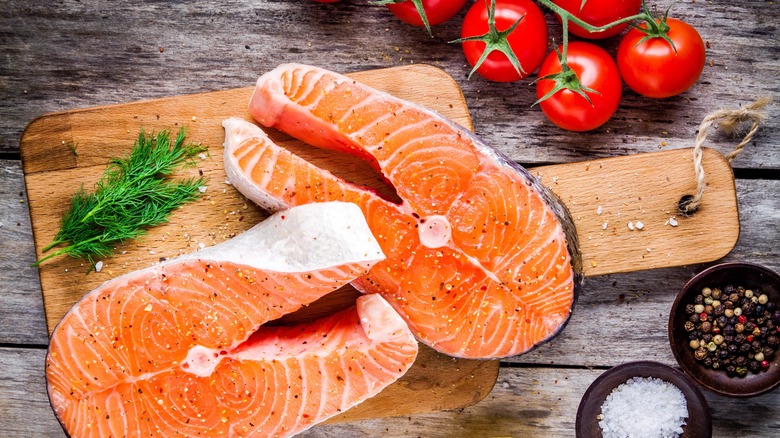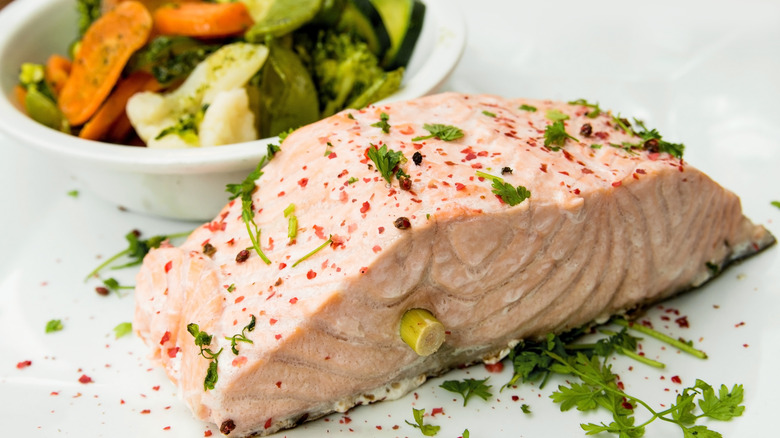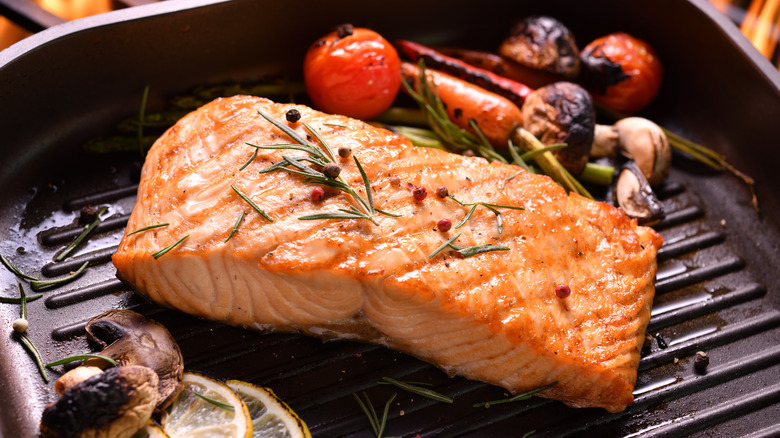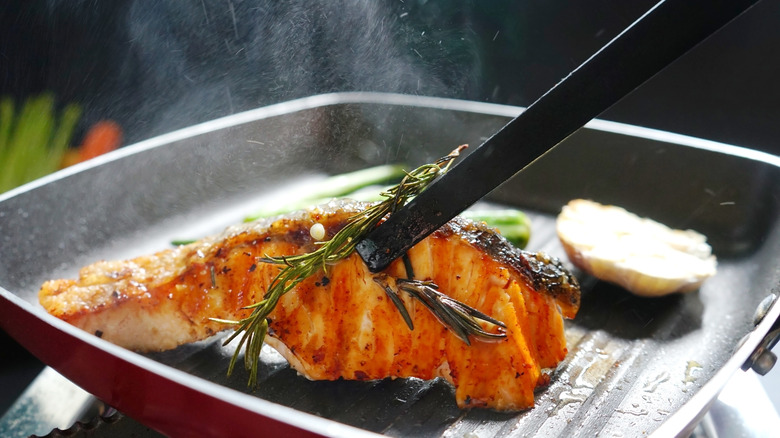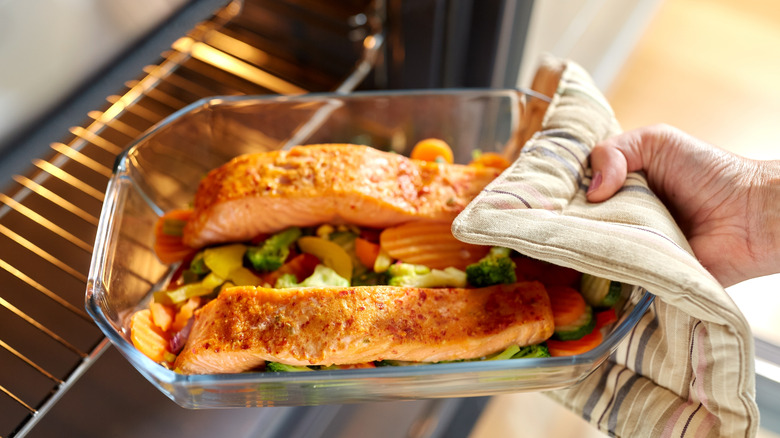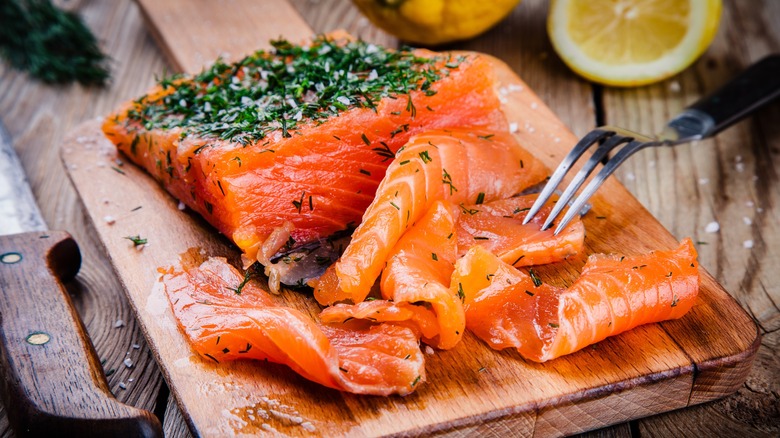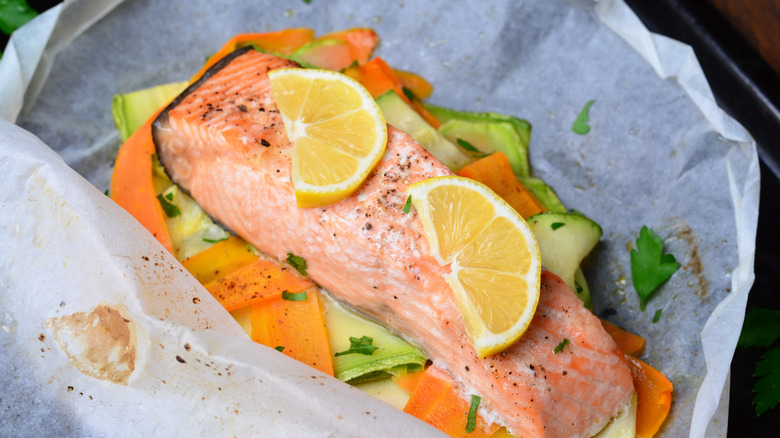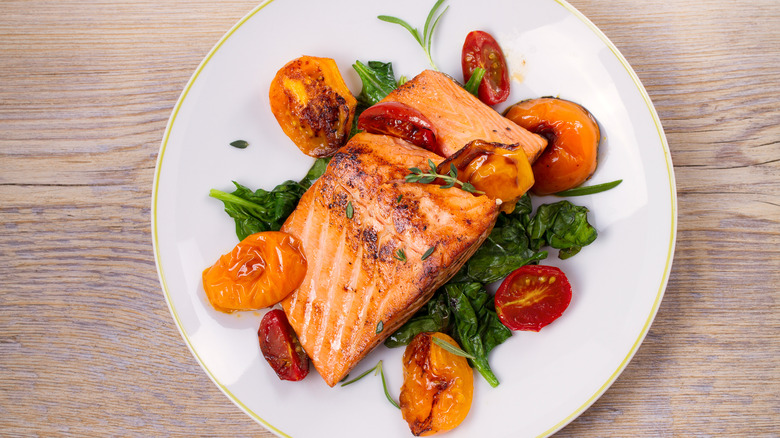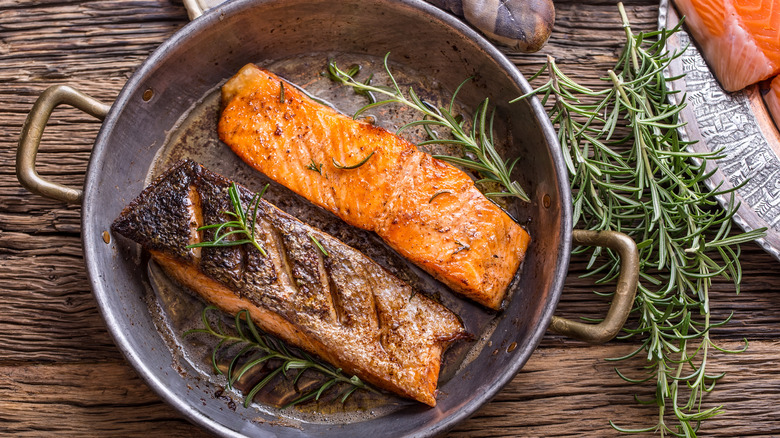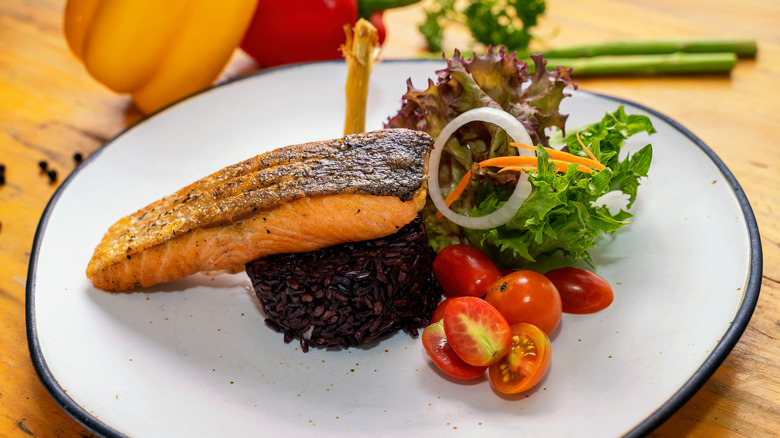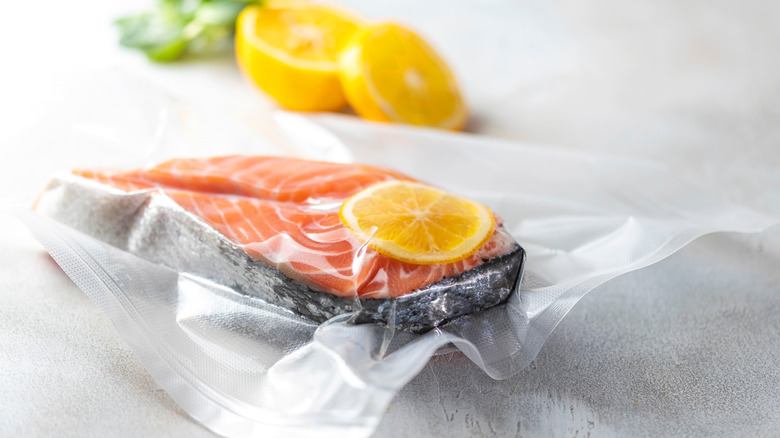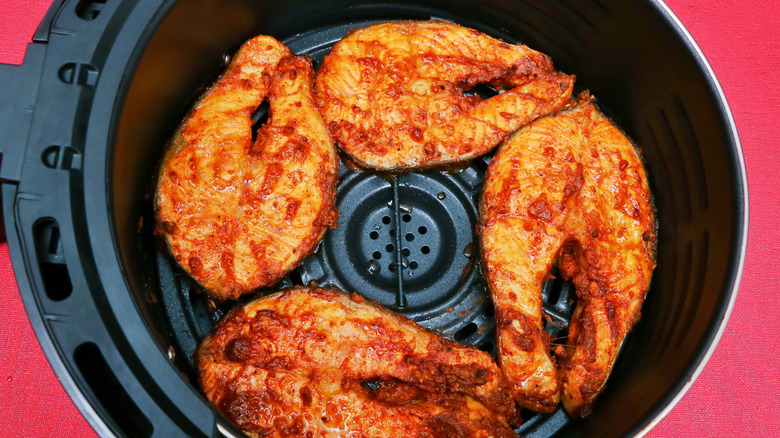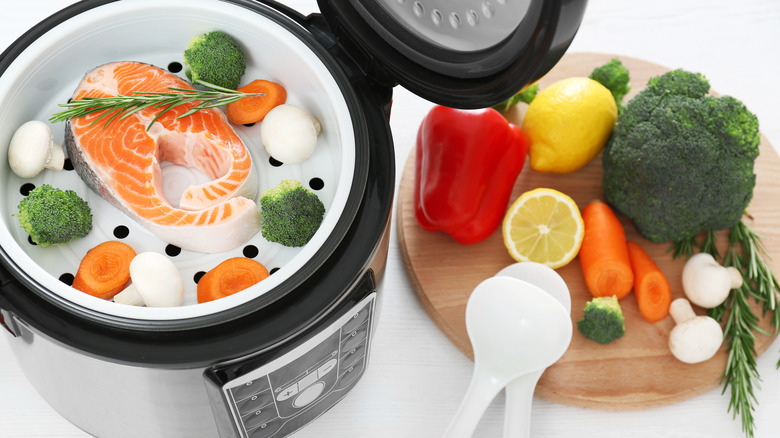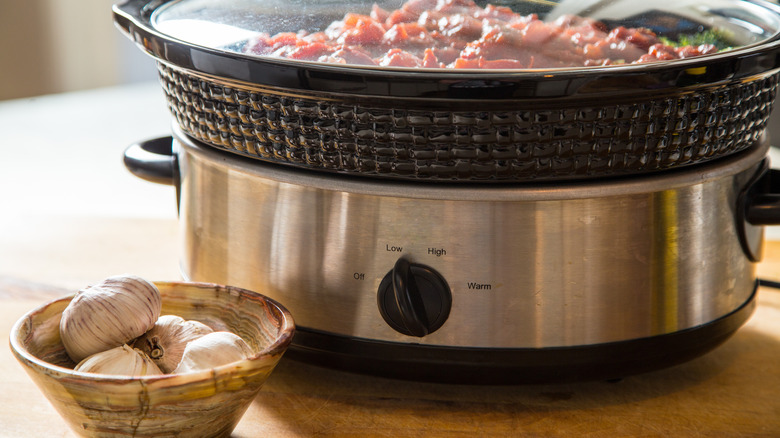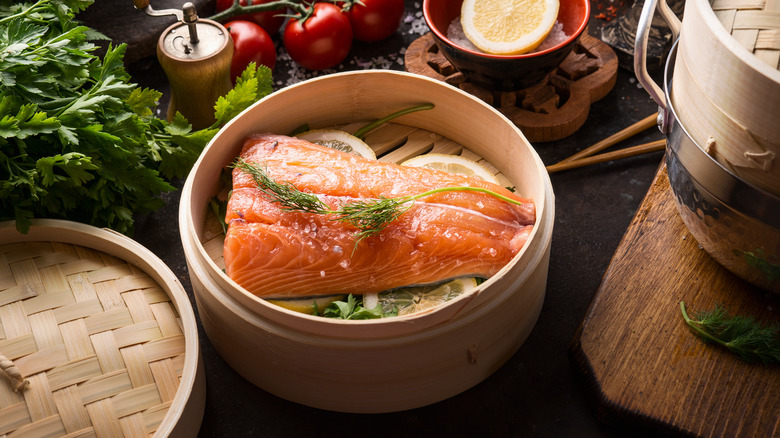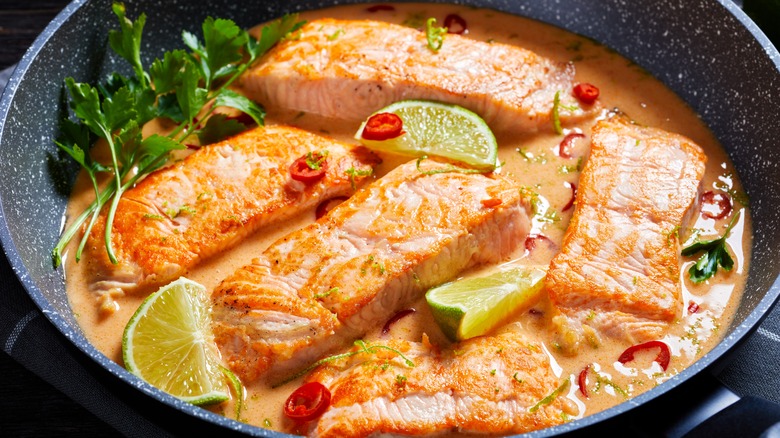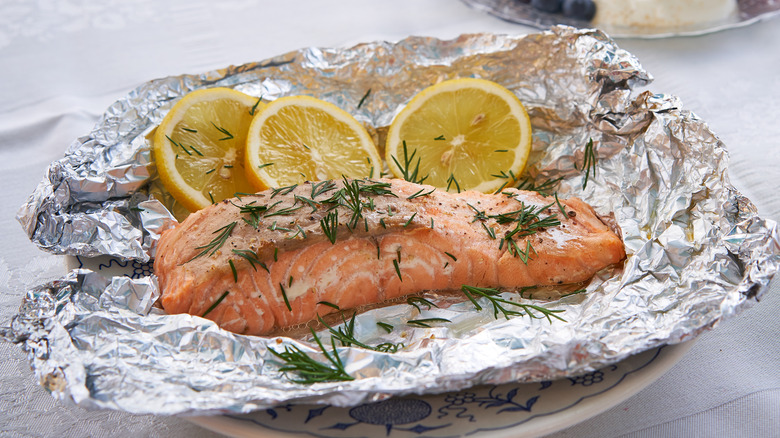How To Cook Perfect Salmon 16 Different Ways
Delicate white fish can be difficult to prepare. Luckily, salmon does not fall into this category. Even though salmon isn't as temperamental to cook as tilapia, it still requires some techniques to cook properly.
Most of the salmon eaten in the U.S. is farmed, so the best way to know what kind of fish you're eating is to go directly to your fishmonger. There are several species of salmon and the most common cut that's used is the fillet. But even if you get a quality piece of fish, you could ruin it if you don't know the right way to cook it. If the only salmon you've experienced has been the over-poached junk that's served on buffet lines, you need to try making your own. Should you leave the skin on? How should you season it? These are questions we can help you with. Here are the best ways to cook a beautiful cut of salmon.
1. Poached
Never poach your salmon in plain water. You're missing out on an opportunity to season the fish! Try adding in some garlic cloves, lemon slices, and a sprig of thyme to the water. This elevates the flavor of the fish from the inside out. Heat the seasoned water on high in a skillet for about five minutes. Gently slide the salmon fillets into the poaching liquid, after dotting the flesh with pats of butter. Sprinkle the fish with salt, pepper, and dried thyme. Bring this to a rolling boil, reduce to a simmer, and poach until the flesh is firm to touch. This should take anywhere from 10-15 minutes. You can change the seasoning of the fish to suit your own tastes, but we highly recommend adding lemon or any other acidity to brighten up the finished dish.
2. Grilled
Grilling fish can be tricky—after all it's not as sturdy as meat. This makes a certain amount of finesse necessary when grilling any type of fish, not just salmon. Some say the skin must be removed for you to enjoy the finished product. We're here to say that those people are wrong. When grilling the fish, the skin crisps into the most delicious part of the meal. Marinate the fillet before grilling, reserving some marinade to coat the top of the fish when cooking. This will keep the salmon from drying out when placed over the direct heat of the barbecue. Place the salmon directly over the charcoal grill, roughly medium heat. Grill uncovered, flip after three minutes, and continue to cook for an additional three minutes.
3. Pan seared
While pan searing, or pan frying, may seem like the simplest method of cooking fish, it is alarmingly easy for the fish to get overcooked. People tend to walk away from the stove and allow the fish to go unmonitored for too long. Make sure you pay close attention to the cooking process, or you'll end up with a dry, cracked fillet of fish.
To pan sear salmon correctly, first heat a large skillet over medium heat for about four minutes. Massage the fillet with olive oil, then place it in the hot skillet. Raise the temperature to high heat and cook for three minutes. Raising the temperature of the pan creates a crispy sear on the outside of the fish, while keeping the inside delicately tender. While the fish is cooking, season with salt and pepper. Flip the fillet and cook for an additional three minutes, then remove it from the pan and serve with a fresh lemon wedge.
4. Baked
Being able to successfully bake a side of fish can make your weeknight dinner routines easier than ever, and it may even be one of the healthiest ways to cook salmon. Stop by your local fish market and pick up a beautiful side of salmon, a bag of rice, and a head of broccoli.
First make sure your fish has been properly marinated; we suggest rubbing the fillets with honey, garlic, and soy sauce. To pack the most flavor into the salmon, leave the fish to marinate overnight. Place the salmon, skin side down, on a nonstick baking sheet. If you prefer to remove the skin, make sure you do so before baking.
Preheat the oven to 450 degrees Fahrenheit and bake the salmon for about 15 minutes. The salmon should look orange throughout when fully cooked. While the fish is cooking, boil your rice and steam the broccoli. You now have a protein-packed, low-carb meal to serve on a busy night.
5. Curing
Curing salmon may seem like a cooking technique out of your comfort zone, but it's actually quite simple. Yes, it's a time-consuming activity, but the delicious result (yummy strips of salted fish) is worth the effort. You'll need, brown sugar, kosher salt, and pepper. Mix all of these ingredients together and completely cover at least a pound of salmon. (Be sure to remove any bones from the fillet before you start.) Wrap the fish in plastic wrap, but don't wrap it too tightly! You'll want the plastic to be loose enough so the moisture can escape as the curing mixture works its magic.
Take a glass bowl and flip it upside down, then place the wrapped salmon over the bowl to allow the water to run off. You can put a plate on top of the fillet to speed up the process and help squeeze the juices out. Now the wait begins. It will take about five days for the fish to completely cure. Make sure to flip the fish daily to ensure that the excess water leaves the fillet. Applying a little pressure can also help to speed the process along. After five days, rinse the salmon thoroughly. The fish is now ready to slice. Grab some fresh bagels, add a shmear of herb cream cheese, and top with your home-cured fish.
6. En papillote
En papillote, or "in paper," is a simple and elegant French technique of baking protein, such as fish, wrapped in parchment. For this ingenious method, the food is cooked by the steam trapped inside the paper. Since most types of fish, including salmon, are sensitive to overcooking, this method allows you to cook the fish delicately using the gentle steam while aromatics of choice infuse it with just the right amount of flavor.
To cook the salmon en papillote, simply fold a large piece of parchment in half, then reopen to lay flat. Place the cleaned piece of fish on one side. Add lemon slices, grated ginger, garlic cloves, or other seasonings you prefer. Fold the parchment over to cover the fish and using your fingertips, fold over the edges securely to create a sealed pouch. Place the pouch on a baking sheet and transfer to the oven to roast until the salmon is cooked through to your liking and flakes easily with a fork.
Ready to wrap your salmon in parchment? Try this recipe from A Couple Cooks for perfectly cooked salmon. Here, salmon is wrapped up with carrots, lemon slices, garlic, and fragrant herbs in paper like a pretty little package. Depending on how thick your salmon is, you can find yourself enjoying this light, nourishing dinner in 10-15 minutes. Weeknight magic.
7. Broiled
Broiling salmon is an easy and fast way to enjoy a piece of fish. Using direct overhead heat from the oven, broiling is an ideal method for cooking a thin to moderate piece of salmon. As it involves cooking at high heat for a short period, broiling is particularly well-suited to fish. The result is beautifully caramelized salmon that's cooked just right on the inside.
To broil salmon, simply place the fish on a lightly oiled foil-lined baking sheet or broiler pan, skin-side down. Run a bit of olive oil on top, then season with kosher salt and freshly ground black pepper. Transfer the pan to the broiler or directly to the oven if your broiler setting does not have a separate compartment. Cook for 10-15 minutes or until the salmon flakes easily with a fork. You're working with extremely high heat here, so be sure to check on it frequently!
Check out this recipe from Food Network for herb and mustard-glazed salmon. Salmon fillets are briefly broiled, then glazed with a ridiculously aromatic, unabashedly mustard-forward mixture loaded with fresh rosemary and thyme. By the time you pull the salmon from the broiler, your kitchen will smell like a five-star restaurant.
8. Roasted
As with vegetables, meat, or poultry, roasting salmon is undeniably easy and foolproof. Its straightforward nature makes this method ideal for those harried weeknights. Place the piece of fish on a baking sheet and with simple seasoning and not much else, you can pop it in the oven and be rewarded with a gourmet dinner in fewer than 15 minutes.
Set your oven to 475 degrees. Add some olive oil or butter to the roasting pan and place the salmon on the bottom, skin side up. After about 5 minutes of roasting, remove the skin, season with salt and pepper, and return to the oven to finish cooking. You can serve your cooked salmon with lemon wedges, pesto, or a gremolata if you like.
For such a streamlined technique, I share with you this recipe for the The New York Times by the master of simplicity, Mark Bittman. Here, salmon is roasted in butter and seasoned with the fresh herb of your choice. The best part? This recipe is infinitely customizable, so feel emboldened to play around with aromatics and seasonings.
9. Braised
Braising is one of the unsung heroes of the culinary world. It produces such on point results and requires almost no work at all. This technique involves cooking the salmon in a flavorful liquid in the oven. By doing so, you end up with tender fish infused with robust flavor — plus you have a built-in serving sauce.
How simple? A quick sear of the salmon to lock in flavor, followed by an effortless saute of aromatics, and lastly a hasty deglazing job using water, stock, or broth. The fish finishes cooking in the oven, bathing in this braising liquid you've created. When it's done, you can even reduce the liquid to sauce consistency and serve it with the salmon. I mean!
Give braising a go with this recipe for salmon and veggies from Food Network. Salmon fillets are braised in seafood stock along with hearty potatoes, carrots, celery, fennel, and onions for a warming dish that consistently turns out beautifully, and so complete, too!
10. Sous vide
Translating to "under vacuum," the sous vide method is a superb and very Parisian way to cook salmon, allowing for greater control over temperature to achieve the desired texture. A sous vide immersion circulator and stockpot are required, or you can use the sous vide function on some multi cookers. One of the most important things to consider with sous vide is the cooking temperature of the water –– cooking temperatures vary from 105 to 130 degrees based on desired texture.
With sous vide in particular, Serious Eats recommends soaking the salmon in saltwater or a plain water brine for a minimum of 30 minutes before cooking, allowing it to retain more moisture. Sous Vide Wizard also recommends coating the salmon in a dry brine to prevent it from overcooking –– coat it in a mixture of salt and sugar for 15 minutes, and rinse before placing it in the sous vide bag.
Cooking is simple-ish –– place the equal-sized salmon in a large ziplock bag or vacuum sealer bag, and add your aromatics or oils, but skip the veggies. Remove the air using a vacuum sealer or by pressing the air out once it has been lowered into the water bath. Cook time ranges from 30 minutes to one hour depending on the thickness –– just add 30 minutes to the time when cooking frozen salmon. After cooking, pat dry and sear it on both sides to create a crispy skin or serve it chilled.
11. Air fryer
Air-frying reduces the amount of calories and fat in foods, making it a healthier alternative to frying in oil. However, air-frying fish in particular raises the amount of "cholesterol oxidation products," or COPs, that are linked to heart disease and high cholesterol, and lowers the healthy omega-3 fatty acids in fish. Web MD recommends adding fresh parsley or chives to reduce the amount of COPs.
Despite its slight pitfalls, cooking salmon in the air fryer is a fast, one-pan, texturally-pleasant way to cook a healthy dinner on the busiest of weeknights. Before cooking, Feel Good Foodie recommends preheating the air fryer to 400 degrees to speed up the cooking process and ensure an even cook. Don't line the air fryer –– while it will make clean up easier, it will block the airflow and cook unevenly. Creating a crispy skin is crucial –– pat the salmon dry before adding seasoning to ensure crispiness. Crowding them in the air fryer will prevent the salmon from becoming crispy, so cook multiple batches if necessary. Place the skin-side down, and cook at 400 degrees for 7-9 minutes, or until it is flaky and pale pink inside. The flavor combinations are endless and versatile with the air fryer, but we recommended trying our sesame teriyaki salmon recipe.
12. Pressure cooker
A pressure cooker cooks salmon to the superior texture, similar to slow roasting or poaching, in a fraction of the time. Martha Stewart's website recommends two methods –– saucing and steaming. With the saucing technique, mix ¾ cup of water and ¼ of sauce, add the salmon, and cook on high pressure for five minutes. Once the pressure is manually released, reduce the sauce using the sauté function. The steaming method does not submerge the salmon –– pour one cup of liquid in the pressure cooker, put the salmon and choice of vegetables in a steamer basket insert, and cook for five minutes on high, and manually release the pressure when done.
When cooking vegetables and salmon at the same time, Detoxinista suggests cooking the salmon for one minute, manually releasing the pressure, adding the veggies, and then cooking on high pressure for zero minutes until the timer beeps. Another option is to cook the veggies using the sauté function until tender. If cooking from frozen, add two minutes to the cooking cycle. Recipes like this salmon recipe with fresh dill keep meal prep and dinner quick, easy, and versatile.
13. Slow cooker
Chili and short ribs don't have to be the only reason to break out the slow cooker –– cooking salmon low-and-slow will make dinner worth the wait. Blog From Scratch Fast uses center-cut salmon filets, but using larger filets works great for meal prepping. It is crucial to line the slow cooker –– From Scratch Fast recommends lining the slow cooker with aluminum foil that extends over the sides to create a sling that can easily lift the salmon out. If cooking a few pounds of salmon, The Kitchn suggests placing up to two layers of salmon in the slow cooker with parchment paper stacked in between them.
After lining, put the desired citrus and aromatics in the slow cooker first, then the salmon, and top with a liquid of your choice –– water, wine, beer, or broth. If cooking one layer, add enough liquid to partially cover the sides of the salmon; if cooking two layers, add enough liquid to submerge the bottom layer and part of the top layer. Cook for one to two hours on low heat only. Start checking the salmon an hour into cooking and then every 20 minutes until it has reached the desired temperature –– keep in mind that the bottom layer of salmon will cook faster than the top layer if cooking in bulk. If you're also cooking vegetables in the slow cooker, cook those first and then add the salmon.
14. Steamed
Steaming doesn't have to equate to boring, bland poultry or veggies –– it's a way to create subtle flavor, especially in the most delicate of foods like salmon. One of the great aspects about steaming is that it doesn't require one type of equipment –– you can use anything from a double broiler or an Instant Pot with a steamer basket, to a bamboo steamer or a metal rack inside a Dutch oven or pot.
Unlike most cooking methods, the skin on the fish is usually removed for even steaming –– just don't forget to grease your steamer basket or rack. The salmon should not be added until the water is hot, but not when it is boiling. Bring the liquid –– water, broth, or wine and a mixture of aromatic and other seasonings –– to a simmer and cover for about 15 minutes to "bloom" the aromatics. Add the salmon to the steamer without letting it touch the simmering liquid; depending on the thickness, most salmon filets will steam in five or six minutes. Steamed salmon is a staple in Nicoise, a classic French salad made with greens, hard-boiled eggs, boiled potatoes, and olives.
15. Poached in oil
Also known as "confit," the process of poaching in oil means cooking food by submerging it in hot oil. As opposed to cold poaching in water, poaching in oil adds incredible flavor and tenderness to delicate foods, especially fish. Plus, according to Epicurious, poaching fish creates less of a smell when cooking compared to pan-searing, and doesn't involve the dangers in frying fish.
It's important to use good extra-virgin olive oil when poaching, but not your best Caprese olive oil. The pan should be large enough to lay the salmon in a single layer, and should be a straight-sided pan or Dutch oven to prevent spillage. Make sure to let the salmon get to room temperature before cooking so it doesn't affect the cooking time. As previously stated, the olive oil should be heated to a low simmer to the point where tiny bubbles oxidize to the top, but not boiling –– around 120 degrees. Immediately transfer to a 225-degree oven for 25 minutes, or until white droplets appear on the outside of the fish. Try your hand at it with this easy poached salmon recipe.
16. Baked in foil
Not only is baking with aluminum foil a versatile and easy-to-clean way of cooking fish, but it keeps fish like salmon moist by locking in the moisture and preventing overcooking. Because of that, you don't have to use oil or other fats to achieve the same result for flaky and buttery salmon. Baking salmon in foil also makes it easy to steam vegetables like potatoes, onion, and carrots at the same time without adding extra pots or dishes. All you have to do is place your ingredients –– vegetables first, and then fish on top –– on a layer of foil, fold, and bring the ends into the center to make a pouch. Cook the salmon in foil at 375 degrees for 15 to 20 minutes. The fish will continue to cook in the foil package once you take it out of the oven, so check it earlier to prevent overcooking.
However, it does have some pitfalls –– in an International Journal for Electrochemical Science publication, studies show that cooking with aluminum foil at temperatures over 365°F for an extended period of time damages the integrity of the aluminum foil and stimulates the breaking down of aluminum foil into the food. Do with that info what you will, when used in moderation, this method makes cooking fish an easy and fool-proof method perfect for hectic weekdays.
